Table of Contents
UNIT II
GRAPHIC DESIGN AND SOCIETY
Throughout India from time immemorial an idiom of simple form provided the language of inward searching, a vocabulary of signs to express
human relationship with the universe. This ability of design to embody, to symbolise, could be seen in various symbols that we encounter in our daily life not only secular, but also political, religious and even common. It may be a rangoli, kolam, alpana or mehendi, it is a deeply rooted essential practice in our society.
Chapter 4
INDIGENOUS GRAPHIC DESIGN AND CULTURE
The word 'indigenous' has the common meaning of 'having originated in or being produced in a particular region or environment'. Therefore, in this sense any ethnic group or community as well as their artistic and cultural expressions and practices may be described as being indigenous in reference to some particular region or location.
In the Indian context, the first ever documented use of the words that may mean 'design' is found in Vedic literature. Vedic hymns always postulated that the entire cosmos is created as 'pre-designed' or 'pre-planned'. In the tenth (Chapter) of there is a hymn called Aghamarshanam . It is a hymn of creation that describes a step-by-step process of creation of the universe. It is said in the hymn that the universe is created as 'pre-designed'. The hymn uses the word kalpa to denote the process of design. The word kalpa is a Sanskrit word which means imaginative composition or a plan. Similarly, in second Adhyaya (Chapter) of the Brahmasutra (a philosophical treatise that captures the essence of Vedic wisdom), it is argued that this universe has a design. In this context Brahmasutra uses the word rachana meaning thereby that the universe has a design, a structure or a composition. The Sanskrit word rachana means composition, construction or organised structure. Also Adhyaya 221 of Brahmasutra argues further that since the universe has a definite design, one cannot think of a design without the designer indicating that there must be a creator was as well as the designer of this universe. Thus, it can be stated that there are two words, kalpa and rachana to denote the activity of design or imaginative composition or organised structure. Apart from the Vedic concept of design, we come Mandala Rigveda across the discussion about design and related artistic activities in many treatises on fine arts, architecture and in other classical literature. These treatises provide a theoretical basis for design by laying down the canons or the rules of artistic and architectural design practices. Design has been an integral part of the profession for many of the communities in India. Communities which were involved in the professions of making artefacts and products, wood-work, jewellery, metal-work, stone-work, ceramics, textile, toys, painting and architecture possessed the traditional wisdom of designing and it was passed on from one generation to the next.
Indigenous design practices encompass a vast area of enquiry. This ranges from adornments of various complexities, pertaining to different functional modalities, religious, social and communicational, to religious symbolism of various kinds the yantras, the pictographs on the walls, to the alpana or kolam done by the woman on the floor to the body tattoos and mehendi outfit and headgear These expressions are used with formal peculiarities evolving out of specific needs both religious and secular in the particular context or environment.
Figure 4.1 Tribal wearing headgear and painted face reflects status of tribe
In a country like India with diverse socio-cultural traditions and customs, design forms change from place to place, from one ethnic group to another with formal peculiarities and each of them are unique. As evident indigenous design practices vary in different functional modes such as religious and social, so the communicatory to objects of use with formal features evolving out of specific religious and secular utilitarian needs also vary. For instance style of wearing Pagri in Rajasthan, keeps on changing after every 15 km.
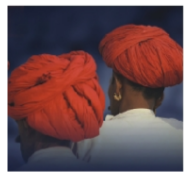
Figure 4.2 Pagri also represents
Thus, social and religious life has affected the design forms of various regions in India and can be classified in various ways. One of the ways of classification would be as ritualistic and utilitarian.
Ritualistic
Tatoo and mehendi designs are excellent examples of ritualistic indigenous graphic designs which have survived from ancient times to modern days.These designs are used in the social rites associated with some beliefs and religious practices. Indigenous designs are also applied to an individual in person in the form of surface ornamentation and decorative devices like graphical marks made on walls or on objects to various forms of jewelleries, headgears and so on. We see girls adorning their hands and feet with mehendi designs during marriage ceremonies and on festive occasions. These are worn not merely for decorative intent. Aesthetic considerations also play an important part in it.
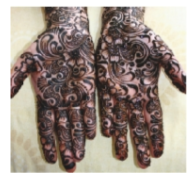
Figure 4.3 Mehendi Design
Mehendi is a temporary form of body art done with naturally prepared paste obtained from a plant, usually found in the Middle East and in other Asia-Pacific regions, where the weather conditions are hot and dry. The leaves are dried and grounded into a fine powder. This powder is mixed with water, eucalyptus oil, tea, coffee, and lime and then applied on the body. Mehendi is traditionally used for its medicinal qualities. Its use became popular in India because of its cooling effect in the hot Indian summers and is still used in sacred and ritualistic ceremonies in India. Mainly used by women, the fine curvilinear lines of the mehendi design are testimony to its feminine essence.
Figure 4.4 A decorative body tattoo
Tattoo is a permanent imprint. There are instances when a tattooed person wants to remove tattoos later, but the removal process is too expensive and painful. And at other times they are unable to remove the tattoos completely and might just be left with a partial tattoo or a permanent scar.
Other than mehendi, more permanent forms of body adornments are also practised in the form of godna, pachakottu, oolki or you may call it a tattoo, which means tapping or marking something. Tattoo designs were initially used to identify specific tribes. Certain communities used it as a status symbol. Apart from using as a form of permanent tribal identification it was also used for decorating bodies even though it is a very painful procedure. The ritual was performed very carefully as putting on the wrong tattoo would jeopardise chances of being one of the tribe and might just permanently mark a person as an outsider.
The tattoo design practice involves piercing into the body, which is done by dropping a sharp-pointed comb into lampblack ink and then inserting it into the skin. Despite the trouble involved, many people got their bodies tattooed, especially arms. Tribal tattoo designs have taken ideas from the tribal art that was pursued by the native and indigenous tribes. Wearing these can variously be attributed to fertility,
magical rites of various kinds, to ideas of beauty, social status or as markers of tribe identity.
Utilitarian
Social customs demand the objects, modes of manufacture and material values determine the form of indigenous designs.

Figure 4.5 A place on the wall for keeping lamp
Figure 4.6 Ghara and Kalshi
Motifs seem to dictate the design of various objects with modifications and adjustments in forms, shapes and sizes done to serve specific purpose. The shapes and forms of pots have variations according to its particular usage and locality. Forms of containers vary depending upon its use from a Handi - cooking pot, Kalshi - a water pitcher, to larger containers Gharas with wide mouth for storing waters brought in pitchers attesting their specific usage. Gharas are made of porous sandy clay with beaten and rounded bottom which keep water cool through evaporation.
There are separate shapes of pots for carrying on the head, at the waist or by hand and special sizes of pots to contain certain measures of rice, oil, milk, etc. Storage pots of different kinds have different local names and their shapes squat or tall with necks broad or narrow, are according to the use they are meant for.
Different sizes and forms of large mangers are used for feeding cattle and other animals which hold hay and large round-bottomed bowls for boiling paddy to make parboiled rice.
Religious activities have also dictated the form and shape of containers and objects needed during the observance of various rites.
The architectural make-up of a holy place or shrine, encapsulates within its design, ideas of hierarchy - the architectural setting itself acting as a tool of worship. For example the elongated dominical structures peeking to a summit that we generally associate with religious sites or the flurry of stairs leading to the main structure all encapsulate within it, ideas of hierarchy, distance and sublime reverence.
Let's us now take up a symbol that we often come across on currency notes, coins, sign boards in front of government organisations or defence forces or on stamps or on top of the dome of Rashtrapati Bhawan and so on.
What is common to all of them?
The Lion Capital.
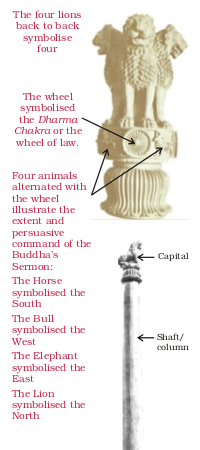
Figure 4.7 Lion Capital
The Lion Capital, erected by Emperor Ashok at Sarnath commemorating the first sermon of Buddha has been adopted as an emblem for modern India. Known as edict columns these capitals are originally surmounted over a long shaft or column erected at places associated with events of Buddha s life or marking pilgrim routes to holy places. These columns function imilar to that of a modern day hoarding, is not it! Both perform certain promotional functions while one advertises dharma the other a particular commodity oth displayed above the eye level and placed at prime location for maximum attention and aspiration. Thia makes a great visual appeal and impact on commuters and observers.
The shaft of the edict appears to be a culmination of an older pre-Buddhist religious tradition of the axis head (mundi). The axis mundi is a symbol representing the point of connection between the sky and earth. It offers means of travel and correspondence between the two realms. The axis mundi appears in all cultures and takes many forms.
The above ritualistic and utilitarian classifications are made for better understanding of indigenous designs. However, we normally find that designs can be classified under more than one category. While understanding indigenous design one needs to look at it from various perspectives. Indigenous design always has some specific meaning. It also has beautiful and aesthetic form which is an integeral and important part of a design. Lastly, the design emerges out of necessity and it has specific function or purpose to perform. Therefore, indigenous design can be understood from the following perspectives.
Contextual Perspective
Objects change their meaning, significance or utility value according to its contextual placement. A rectangular yardage of cloth could be wrapped around or tied in various ways to create different articles of clothing When wrapped around the head it acts as a pagri, when draped around the upper torso it becomes the shawl or the uttariya and when wrapped or tied around the waist, covering the lower part of the body it becomes the antariya the kanccha or the lahenga.
Figure 4.8 Lahenga
Semiotic Perspective
Throughout India from time immemorial an idiom of simple form symbolises a language of inward searching, and a vocabulary of signs to express the human relationship with the universe. This makes designs meaningful in some or the other sense. Semiotic perspective create an understanding, the relationship of indigenous designs which evoke a meaning in the minds of the users. Since graphic symbols are visually appealing and effective, the issues are even more important.
Figure 4.9 Symbolic Sun
On the other hand the ability of design to embody to symbolie, could be seen as another functional obligation it lends itself to as seen in the various symbols that we encounter in our daily life not only secular, but also political, religious and cultural. This creates a great visual appeal and impact on the observers .
Figure 4.10 Anga
Symbolised design depicting deities could also be observed in the amazing structure of Anga, the supreme deity of Muria tribe in Bastar, Chhattisgarh. The Anga has a specific form created by three para lel poles joined together by crossbars and tied up, with peacock feather sticking at its joints. Coins are fixed on the upper surface of two sides of poles. Anga is carried on shoulders by its bearers. The central pole is Anga himself, with front part bending upwards at an angle and then bend again parallel to the pole to form the head, providing a feeling of tremendous forward thrust. Anga dominate its powerful presence as it is polished by a dull black colour. It strikes admiration to the beholder and when possessed, moves along with great speed on the shoulder of its bearer.
Functional Perspective
Designs are used to perform a function. Let us see an example from Sanchi to illustrat that how form follows function. The Yakshi bracket figure is an architectural design. The notion of supporting the weight of the lintel which a bracket practically does is not only understood in the dynamic stance of the figure but also in flayed gesture of the feet carrying the connotation of the weight.
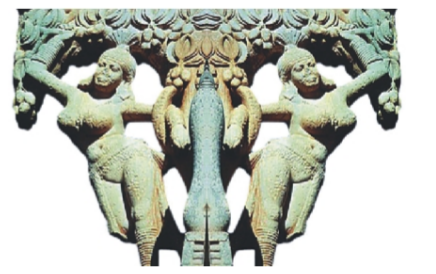
Figure 4.11 Yakshi
Let us look into how the scarcity of urban space is being utilised for maximum utility. We see space orientation of a small shop or any road side tea stalls; where the claustrophobic space is divided vertically into a series of tiers; the upper space for the daily transaction and servicing to take place while the lower section utilised either as a workspace or storage. This experience of functionally organised space around us contributes to nurture our sense of visual space and graphic sensibility.

Figure 4.12 Terracotta form from Ider, Gujarat for ritual use
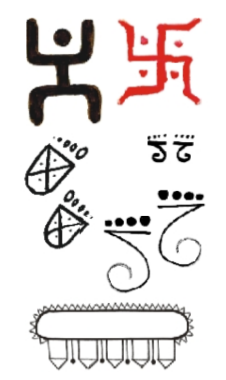
Figure 4.13 Various symbols of indigenous rituals
Cultural and Social Forms of Signification
Our social and cultural life leads to the creation of various forms of signification like
Pagri//turban (to signify class, caste, profession or religious affiliation)
Mangal sutra (confirming the marital status of a woman)
Religious drawings like Swastikas, geometric diagrams like triangles and inverted triangle to signify male and female faculties of creation as seen in the yantras and wall decorations or the mandalas presenting a microcosmic view of the macrocosm, etc.
Memorial pillars erected by the tribal communities in memory of the deceased (like the Gatha for male and for the female erected by the Bhils, also a practice among Korkus known as Shadoli Munda or the Maria memorial pillars carved out of whole trunks of trees).
Marriage pillars also known as Mangrohi Khambs were erected by the Gonds not only as a fertility symbol but also to ward off evil eye. They used to immerse the pillars in the river after performing the ritual.
Figure 4.14 Votive terracotta elephant from Bastar
The broom and the chappal/slippers tied on a long bamboo pole in construction sites to ward off the evil eye.
Votive figures (terracotta horses, buffaloes, elephant and camels are made as devotional objects).
Deities signified through pieces of stones arranged under trees, flag poles and tridents, peacock feathers arranged on top of a pole ( chandi by the Gonds) or the polished boulders from river beds arranged on top of the other signifying Shiva.
Exercises
1. What do you understand by the term indigenous design? Explain with few examples.
2. What do you understand by body designs? How is a mehandi design different from the body tattoo?
3. What do you understand by the term memorial pillars? Elaborate with few examples.
4. What are Edict columns? What do you understand by the term Axis Mundi?
5. Discuss in brief the role a culture plays in creating symbols. Explain with examples.
6. Explain that the society and objects are related to their ritual and utility.
Practicals
1. Identify five traditional or contemporary forms/objects from day-to-day uses based on their function and make pictorial analysis.
2. Collect some (three to five) designs from your local environment and modify them to make more effective and aesthetically appealing.
3. Design a motif and convert it into three-dimensional drawing.






